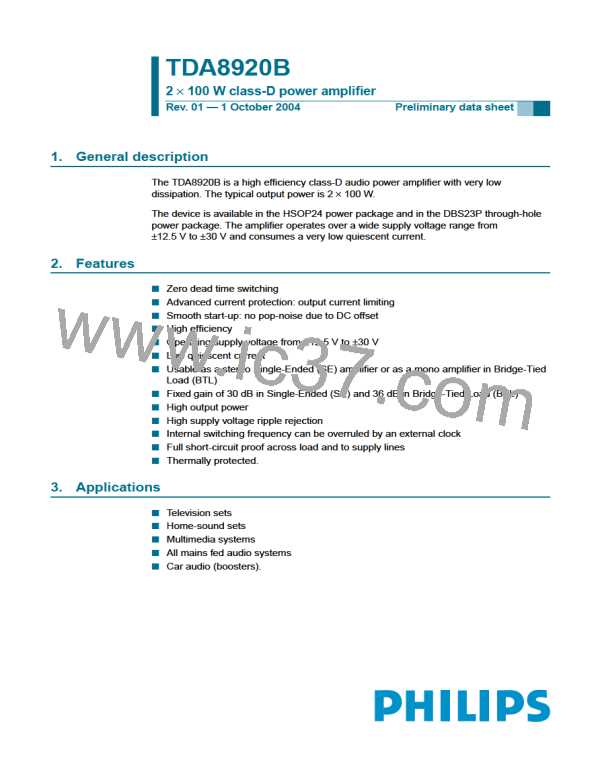TDA8920B
Philips Semiconductors
2 × 100 W class-D power amplifier
A typical value for the capacitor on the PROT pin is 220 pF. After a fixed time of
100 ms the amplifier is switched on again. If the requested output current is still too
high the amplifier will switch-off again. Thus the amplifier will try to switch to the
Operating mode every 100 ms. The average dissipation will be low in this situation
because of this low duty cycle. If the overcurrent condition is removed the amplifier will
remain in Operating mode once restarted.
In this way the TDA8920B amplifier is fully robust against short circuit conditions while at
the same time so-called audio holes as a result of loudspeaker impedance drops are
eliminated.
13.7 Pumping effects
In a typical stereo half-bridge (Single-Ended (SE)) application the TDA8920B class-D
amplifier is supplied by a symmetrical voltage (e.g VDD = +27 V and VSS = −27 V). When
the amplifier is used in a SE configuration, a so-called ‘pumping effect’ can occur. During
one switching interval, energy is taken from one supply (e.g. VDD), while a part of that
energy is delivered back to the other supply line (e.g. VSS) and visa versa. When the
voltage supply source cannot sink energy, the voltage across the output capacitors of that
voltage supply source will increase: the supply voltage is pumped to higher levels. The
voltage increase caused by the pumping effect depends on:
• Speaker impedance
• Supply voltage
• Audio signal frequency
• Value of decoupling capacitors on supply lines
• Source and sink currents of other channels.
The pumping effect should not cause a malfunction of either the audio amplifier and/or the
voltage supply source. For instance, this malfunction can be caused by triggering of the
undervoltage or overvoltage protection or unbalance protection of the amplifier.
Best remedy for pumping effects is to use the TDA8920B in a mono full-bridge application
or in case of stereo half-bridge application adapt the power supply (e.g. increase supply
decoupling capacitors).
9397 750 13356
© Koninklijke Philips Electronics N.V. 2004. All rights reserved.
Preliminary data sheet
Rev. 01 — 1 October 2004
19 of 34

 NXP [ NXP ]
NXP [ NXP ]